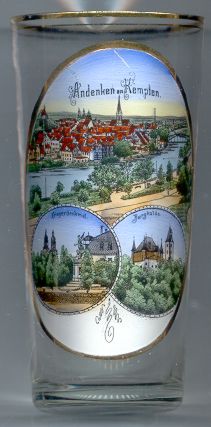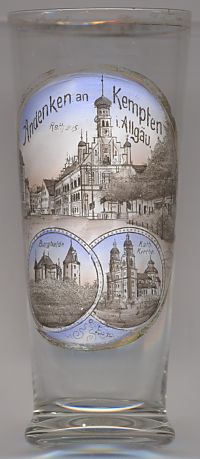

|
| DEUTSCHLAND | GERMANY |
| Bundesland: Freistaat Bayern | Bavaria |
| Regierungsbezirk: Schwaben | |
| Stadt: Kempten (Allgäu) |
Kempten is situated at an elevation of 698 m on the river Iller in the Allgäu region of Swabia. The name Kempten which probably was named Kambodounon. After the Romans had occupied the area in about 15 BC they began to build their own town between about AD 10 and 54 and named it Cambodunum after the previous settlement. After moret han 200 years of constant battles with the Alemanni, the Romans eventually left the region in 488. The Alemannic settlement was then destroyed by the Frankish kingdom in 683. Benedictine Monks from the monastery at St. Gallen came into the area in 747 and founded a monastery at Kempten in 752. Soon the monastery was one of the most privileged abbeys of the Frankish kingdom. When it was destroyed by the Hungarians in 940, bishop Ulrich (St. Ulrich) of Augsburg had it rebuilt. Again the monastery became highly influencious and in 1213 the abbots obtained the rank of sovereign Imperial princes. The town of Kempten, however, was detached from the territory of the prince abbots when it became a Free Imperial City in 1289. The following centuries were marked by the severe opposition between the Catholic prince abbots and the Protestant city. Kempten joined the Schmalkalden federation of Protestant princes and cities in 1535. In 1609, Kempten joined the Protestant "Union", while the prince abbots joined the Catholic "Liga". During the subsequent Thirty Years' War (1618–1648) Kempten was therefore occupied and looted several times by (Catholic) Imperial and (Protestant (Swedish) troops. At the end of the war only about 900 inhabitants were left in the city. Only the Peace of Westphalia of 1648 prevented that the town was incorporated into the territories of the prince abbots. During the Napoleonic Wars, Kempten was occupied at first by French troops in 1796, follwoed by Bavarian troops in 1802. After the secularisation of 1803 the abbots lost their sovereignty, the town lost its status as Free Imperial City, and both were incorporated into the Electorate (1806 Kingdom) of Bavaria. In 1811 the administration of town and abbey was merged, and both were finally united as the city of Kempten in 1818.

The  St.-Mang-Kirche (Protestant parish church St. Magnus) [left, no. 1528: top picture: background centre, barely visible]
was built beginning in 1426 in Gothic style in place of an older Romanesque church. The south tower received its final height (66 m)
in 1440. The interior of the church was remodelled in Baroque style in 1767. During a major renovation in 1857 in neo-Gothic style most of the
older decorations were removed. A further renovation in 1912, however, restored the church according to the state of 1767.
The church is named for St. Magnus, a Benedictine monk from St. Gallen who had helped to
christianize Swabia. The legend tells that he had killed a dragon or serpent at Kempten and had re-established the parish.
St.-Mang-Kirche (Protestant parish church St. Magnus) [left, no. 1528: top picture: background centre, barely visible]
was built beginning in 1426 in Gothic style in place of an older Romanesque church. The south tower received its final height (66 m)
in 1440. The interior of the church was remodelled in Baroque style in 1767. During a major renovation in 1857 in neo-Gothic style most of the
older decorations were removed. A further renovation in 1912, however, restored the church according to the state of 1767.
The church is named for St. Magnus, a Benedictine monk from St. Gallen who had helped to
christianize Swabia. The legend tells that he had killed a dragon or serpent at Kempten and had re-established the parish.
The  soldiers' monument [left, no. 1528: bottom left picture] was located on the site which today is
occupied by Kempten's central bus station.
The monument was created by the sculptor Syrius Eberle (1844–1903).
The bronze statues were melted down during World War II.
soldiers' monument [left, no. 1528: bottom left picture] was located on the site which today is
occupied by Kempten's central bus station.
The monument was created by the sculptor Syrius Eberle (1844–1903).
The bronze statues were melted down during World War II.
The  Burghalde [left, no. 1528: bottom right picture, and right no. 2029: bottom left picture] is located on a hill above the historic town.
Originally the site was occupied by a late Roman stronghold of the 3rd and 4th centuries, which was later replaced by a castle
of the abbots of Kempten. The castle was destroyed by the citizens of Kempten in 1363. In 1488 a new castle was built, which also
was part of the town's fortifications. Most of this castle was torn down in 1705. Only the old castle keep has remained from that preiod.
In 1870 the 'gatekeepers house' was restored in romantic Historicist style. Since 1950 the Burghalde is used as a stage for
open air performances.
Burghalde [left, no. 1528: bottom right picture, and right no. 2029: bottom left picture] is located on a hill above the historic town.
Originally the site was occupied by a late Roman stronghold of the 3rd and 4th centuries, which was later replaced by a castle
of the abbots of Kempten. The castle was destroyed by the citizens of Kempten in 1363. In 1488 a new castle was built, which also
was part of the town's fortifications. Most of this castle was torn down in 1705. Only the old castle keep has remained from that preiod.
In 1870 the 'gatekeepers house' was restored in romantic Historicist style. Since 1950 the Burghalde is used as a stage for
open air performances.
The Catholic
(see also list of other basilicae minores depicted on glasses of this collection)

The  town hall (Rathaus) [right no. 2029: top picture]
was built in 1474. The eastern façade was altered in 1562–1564. During the renovation of 1874/1875
the town hall was redecorated in Renaisance revival style.
town hall (Rathaus) [right no. 2029: top picture]
was built in 1474. The eastern façade was altered in 1562–1564. During the renovation of 1874/1875
the town hall was redecorated in Renaisance revival style.
 basilica Sankt Lorenz [right no. 2029: bottom right picture],
the church of the Benedictine monastery, was built in 1652–1748.
It was the first new church in Germany that was begun after the end of the Thirty Years' War (1618–1848).
The architects of the Baroque church were Michael Beer and Johann Serro.
The top parts of the two towers were added in 1900.
The 1969 the church was awarded the title Basilica minor.
basilica Sankt Lorenz [right no. 2029: bottom right picture],
the church of the Benedictine monastery, was built in 1652–1748.
It was the first new church in Germany that was begun after the end of the Thirty Years' War (1618–1848).
The architects of the Baroque church were Michael Beer and Johann Serro.
The top parts of the two towers were added in 1900.
The 1969 the church was awarded the title Basilica minor.
![[scale]](lineal.jpg)